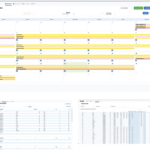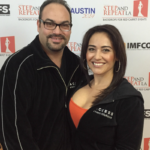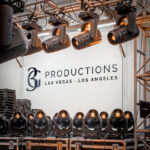High End Systems turns 30 years old this year; that’s quite a milestone for this Austin-based lighting manufacturer. High End has gone through their share of changes over the years, but many of the same familiar faces that built this company are still with HES today. In fact, they’ve been growing so fast that they now have the largest sales team assembled in years. And yes, they are still raising the bar in our industry by uniquely being #ALLABOUTLED. Sit back while we tell you a little about this company.
The Revolution
HES has never been one of those companies that follows suit in anything. They preferred to pave the road in their own way, ever since Richard Belliveau invented their first fixture, the Color Pro, back in 1987.

By 1989 High End started selling the Intellabeam, a moving mirror scanner. In 1991 Dire Straits took the fixtures on tour, and a revolution in the lighting business was under way. These were not the first moving lights built, but they had three important things going for them. They were the first moving lights to tour that didn’t need constant repair. They were made in the USA. Third and most importantly, anyone could buy these affordable fixtures. Prior to this fixture busting on the scene, U.S. lighting vendors had to rent their moving lights for beaucoup bucks from one of just two companies in America. The revolution began when any lighting company owner could now supply their own movers for a gig.
History continued to be made as DMX controlled strobes (Dataflash, AF1000) were invented. The F-100 fog generator blew huge plumes of smoke out, reinventing the theatrical fog machine as we knew it. And HES was the first manufacturer to actually design their own lab to build dichroic color filters on site.
Along the way, High End kept making advances with yoke lights, particularly the Studio Series of spots, colors and beams. HES set precedents that others followed, and for the rest of the 90’s the company ruled the roost, ushering us into the digital age. Come the new century, the Showgun was the first hybrid light we ever saw. It was a big footprint beam light — yet it had gobos, and it could change from a wash light to a hard edge beam. They topped it off by being the first moving light to add LEDs to the fixture as well, for eye candy.

The Next Wave
It’s fair in a way to compare some of High End’s thought process with the folks from Apple. They jumped into the millennium with a series of new products that, until they were seen and used by lighting professionals, nobody knew what to make of them. They unveiled the Catalyst Orbital Head, the first commercially available product to move video imagery in a 3D space, licensed from Wynne Willson Gottelier Ltd. (WWG). Then came projectors inside a moving yoke fixture with an internal media server. High End had the foresight to see that media servers, digital moving lights and the advent of LED pixels on a moving head were all going to be the wave of the future.
In 2008, High End was acquired by Barco, and by 2010, there must have been 20 global companies making their own versions of hard edge and wash fixtures with arc lamp sources. A new trend of lights called beams came out. These were followed by hybrids and many LED wash lights that were based around the format of the original Showpix. High End Systems had zero aspiration to design a model of a product someone else was already building. Richard and his team had known for years that LED was the wave of the future. High End Systems was the first company to actually do away with the arc-sourced lamps altogether. While other manufacturers dabbled with an occasional dim moving light powered by a LED engine in their repertoire, HES went all in, betting the future of the company on the success of the White LED and HOG 4.

The Renaissance
Over the last few years, High End Systems introduced a whole line of theatrical moving yoke lights as well as what they are referring to as Effects Series lights (also known as “A Richard Belliveau Concept brand”). The release of the Shapeshifter this decade started the new look to the effects side of High End Systems. Once again, LDs looked at one of Richard’s innovations and did not initially know what to do with it. It was an effects light that had seven individually controlled LED panels on its face that could pan and tilt and change color, in addition to the whole fixture panning and tilting. It took a while before some LDs took them on rock tours and realized, in the words of Mötley Crüe’s LD Matt Mills, “These things are extremely badass!” After that, designers started spec’ing the Shapeshifters on shows and realizing they were extremely versatile and bright for LED fixtures.

High End knew that what the industry needed was a compact, efficient white light LED engine that they could use to replace the arc-source lamp. Once an arc sourced lamp is struck in the morning, it generally stays struck until after the show, dimming as it adds up hours of use. The thing about a white light LED engine is that the LEDs are only in use when the dimmer channel is turned on. An arc source bulb may last 750 to 1,000 hours. The LED engine lasts 50,000 hours. I sat down and did the math with HES Sales Director Sean Hoey; if a production operated a fixture for 14 hours a day, 7 days a week, and 52 weeks a year, the operating hours on the LED engine would be about 5,100 hours per year. In other words, the LED engine could outlive the fixture.

With the future vested in the white LED engines as a light source, the company’s design team has been extremely busy the last five years. Their goal was to develop a wide range of fixtures that could complement each other, yet rival in brightness that is on the market with arc-sourced fixtures today. They have succeeded where others have failed. LDI 2016 validated the claim by HES that white LED fixtures are bright enough to stand side to side and replace competitive arc-source fixtures today.
With the new extremely bright white LED engines, High End Systems developed the first real range of white LED fixtures for every application. HES split the hard edge and wash light fixtures into three separate ranges, the 1000, 1500, and the 2000 series. The 1000 series utilizes a 440-watt light engine and is reminiscent of the Vari*Lite VL2500, Martin MAC or Robe 700-watt series of arc-source lights meant for theaters and smaller shows. The SolaSpot 1500 utilizes a brighter 400-watt white LED engine. It is comparable in output to the VL3500 spot. The new 2000 series is the brightest of the range, featuring a 600-watt light source with up to 26,000 lumens of output, which compares to a Mac Viper or VL4000 fixture. All these new fixtures features a crisp, 6500°K white output.

At LDI 2016, HES introduced the SolaTheatre, the first high-powered white LED automated luminaire to feature fanless operation. While the other SolaSpot and SolaWash fixtures are extremely low noise, the SolaTheatre is virtually silent, making it particularly applicable for use in theatrical and studio applications.
In addition to their SolaRange line of moving heads, High End Systems has augmented their family of LED “effects lights.” The company originally released the SolaWash 19 and 37 individual LED fixtures (often referred to as pancake lights). Each comes with a face full of 15-watt RGBW LEDs that offer dynamic patterns of pixels. These models zoom from 12° to 65°. As with the Shapeshifter, many of the effects lights come with Indigo Highlighters, a group of small indigo LEDs that emit a true indigo wash. Among the new range of effects lights High End showed at LDI were the Quad, HEX and UNO models.

Continuing to Raise the Bar
Besides boasting the brightest White LED fixtures in the industry, Richard Belliveau and High End Systems continue to innovate. The new SolaRange fixtures include their patented Lens Defogger, an element that heats the exterior lens of the fixtures. High End determined that an unacceptable amount of contrast and lumen output is lost in many fixtures due to fog/haze fluid attracting dirt and sticking to the outer lens assemblies of its’ fixtures. This heating element dissipates the film, keeping the techs from having to wipe and clean the lenses regularly at gigs. Another unique innovation Belliveau came up with is a filter that can raise the CRI/TM-30 measurements of the LED source.
As of 2016, there was still no competition as to what they are building. These days High End Systems is back in force and at the top of their game with 65 full time employees, many of who do the QC work and test every fixture rigorously. Vendors are catching on that HES fixtures are affordable and just as reliable as they have always been. The difference is they will never buy another lamp, resulting in significant cost savings over the course of a fixture’s life. Lighting designers are catching on that everything they need in a fixture — from framing shutters to fast zooms, electronic strobe rates and dimmer chases directly from the light source — are all included.
The Hog 4 family of control consoles continues to make great strides; new software is released every few months with major revisions implemented that users have requested. High End Systems proudly hosts the Hog Factor Competition each year, a university Hog 4 programming contest where students get to present a previsualization show file based on a song and a light rig that HES provides. Guest LDs judge the finals, and the winners get great prizes for their schools, including consoles and scholarship money. This year almost 30 teams submitted designs.
If you have been wondering what High End has been up to the last five years, it’s time you take a closer look. As they say, Seeing is Believing. High End Systems has been an innovator for thirty years and they continue that tradition today. Look at some of the latest products HES has on the market now.


